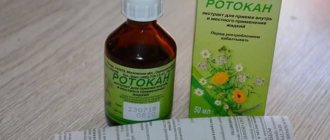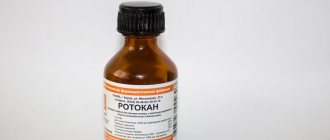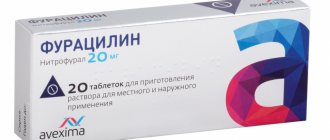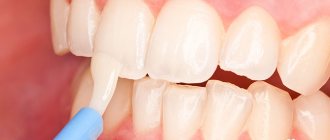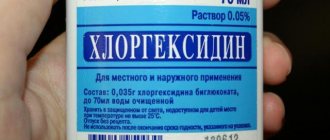From this article you will learn:
- what does Chlorophyllipt help with?
- how to dilute for gargling,
- reviews when used in ENT practice, price 2022.
The article was written by a specialist with higher medical education.
Chlorophyllipt is a herbal medicine with antimicrobial and antiseptic activity, which contains a mixture of chlorophylls from eucalyptus leaves. Chlorophyll is the pigment that gives the green color to the leaves of eucalyptus and other plants, and it is to this that the drug owes its name. The drug has the following forms of release: an oil or alcohol solution (contains ethanol), a spray form, and lozenges.
As we said above, chlorophyllipt has moderate antimicrobial activity, but it must be taken into account that it is mainly effective only against staphylococcus. Thus, the drug cannot boast a wide spectrum of antibacterial action, and it makes sense to use it primarily only as part of complex therapy. The drug also slightly stimulates regeneration processes (can be used for burns and trophic ulcers). When administered by inhalation, the drug slightly stimulates expectoration of sputum.
Chlorophyllipt: alcohol and oil solution
Chlorophyllipt spray and lozenges –
Forms of release of the drug –
- alcohol solution 1%,
- oil solution 2%,
- Spray for the throat,
- lozenges.
It should be noted that the drug has a fairly narrow range of indications for use. For example, the most popular alcohol form of the drug is not recommended for use in children under 18 years of age for oral administration (this means that the inhalation route of administration is also prohibited), as well as in pregnant and lactating women. In addition, inhalation of an alcohol solution is prohibited in case of atrophic processes in the mucous membrane of the upper respiratory tract, for example, in the atrophic form of chronic bronchitis, as well as bronchial asthma, bronchospasm.
It should be noted that Chlorophyllipt’s instructions for use of the drug are very sparse and do not contain detailed treatment regimens for diseases of the ENT organs. Therefore, patients look for information mainly on forums, where the “authors” sometimes recommend adding alcoholic Chlorophyllipt even to breast milk for newborns!!! Most of the harm has been written about the use of the alcohol form of the drug for inhalation, although courses of inhalation with alcohol solutions (especially in children) lead to atrophy of the ciliated epithelium of the bronchi, which, on the contrary, only contributes to the development of chronic bronchitis. As for the oil form of the drug, inhalations with it cannot be done in children under 2 years of age.
What is Chlorophyllipt used for?
Chlorophyllipt in tablet form is prescribed for diseases of the upper respiratory system, as well as for stomatitis. The solution is prescribed after surgery, childbirth, or infection. Indications also include:
- pneumonia;
- pleurisy;
- gynecological pathologies;
- burn disease;
- peritonitis.
Parenteral use of the drug is effective for tuberculosis and erysipelas.
The product helps with persistent wounds and soft tissue defects.
The instructions also indicate other indications for use depending on the form of the drug.
Chlorophyllipt: price and composition analysis
For Chlorophyllipt spray the price for 2022 will be about 210 rubles (for a 45 ml bottle equipped with a spray nozzle). The cost of a 2% oil solution will be from 150 rubles per 20 ml bottle. For a 1% alcohol solution of Chlorophyllipt, the price starts from 240 rubles (for a 50 ml bottle). As for lozenges, the cost of 1 package of 20 tablets starts from 150 rubles.
The drug Chlorophyllipt is produced by several manufacturers, but regardless of this, the main component of the drug always remains the extract of eucalyptus leaves - in the form of essential oil. The value of eucalyptus oil is determined by the content of a substance called “Cineol”, which gives the drug an antimicrobial and expectorant effect. Some other properties of this drug, which are beautifully described in the instructions (for example, accelerating wound healing) do not have much therapeutic value, because This effect of the drug is rather weak.
It should be noted that the content of cineole in eucalyptus oil is not constant and depends - 1) on the type of eucalyptus oil that the manufacturer uses, 2) on the concentration of eucalyptus oil in the drug solution. In addition to cineole, eucalyptus essential oil also contains other substances: chlorophyll, organic acids, aldehydes, tannins (about 6%), as well as useful trace elements, such as selenium, zinc and manganese. It should be noted that the reviews for the drug Chlorophyllipt are mostly positive, but as you will see below, the drug deserves attention only as part of complex therapy. Below we will consider in order all forms of release of this drug.
How to take Chlorophyllipt for children
The instructions for the drug do not contain clear recommendations regarding its use in childhood. The manufacturer claims that there is not yet sufficient experience in taking the medication in the treatment of children.
But since the drug is well tolerated by the body and rarely causes adverse reactions, it is often prescribed to children.
The oil solution can be used for colds and sore throat. They also have their nose dripped and their throat treated.
The solution can be used to treat wounds and cuts. In adolescence, it helps fight skin rashes.
Treatment of children and special patients
"Chlorophyllipt" refers to drugs with a completely natural, herbal composition. That is why the drug can be used to treat children from a very early age.
Just before gargling with Chlorophyllipt, you should make sure that the child is old enough for this procedure and knows how not to swallow the solution.
- We choose a means for gargling for a child and teach the child to perform a useful procedure
Alcohol infusion of "Chlorophyllipt" is a popular drug in neonatology and pediatrics. As an external remedy, it is often prescribed to treat the umbilical wound in newborns instead of the usual brilliant green. This is explained by the high effectiveness of the drug against the staphylococcal group of bacteria. Also, the Chlorophyllipt solution is used orally in newborns, in the dosage indicated by the pediatrician, in case of general infection with staphylococcus.
Due to its high efficiency and minimal contraindications, Chlorophyllipt is actively used in the treatment of pregnant and lactating women. After all, it is very important to properly treat the mother and not harm the baby. The drug "Chlorophyllipt" copes with this very well.
Chlorophyllipt - indications for use
The drug does not fight the symptoms, but the causative agent of the disease, accelerates tissue regeneration, and restores damaged mucous membranes. After the first rinses, it relieves pain and eliminates symptoms. Indicated for rinsing when:
- tonsillitis;
- laryngitis;
- inflammation during acute respiratory infections, ARVI, influenza;
- flux.
The drug is suitable for the treatment of cervical erosion, vaginitis, and trophic burns. A fast-acting remedy relieves inflammation and minimizes pain. Also performs an antiseptic function. Resistant to pathogenic microflora, fights bacteria even several hours after use.
Gargle for inflammation of the tonsils, respiratory diseases, and lesions of the mucous membrane. Relieves pain in the oral cavity from tonsillitis, tonsillopharyngitis, gingivitis, stomatitis. Tightens gaping wounds that are difficult to heal.
Relieves the disease and prevents the spread of pathogenic microflora.
Chlorophyllipt is considered a safe drug, as it consists of natural ingredients. Can be used as a means of self-medication, available for home use. Facilitates the course of pathological conditions, removes toxins and toxic substances from the body. Useless against viral diseases.
Spray Chlorophyllipt: reviews, instructions
Chlorophyllipt-Vialine spray (manufactured in Armenia) is a combined drug for local use in the oral cavity (for the treatment of tonsillitis and pharyngitis), but can also be used to treat the nasal cavity for rhinitis. Available in 45 ml bottles with a spray nozzle. The spray is a green liquid with a characteristic odor. Does not contain alcohol.
Composition of Chlorophyllipt spray (Vialine):
| Active substances – → extracts of medicinal plants (eucalyptus leaves, stinging nettle, St. John's wort, wormwood, dubrovnik) |
| Excipients: purified water, sodium benzoate. |
→ Spray Chlorophyllipt: instructions for use (download in PDF)
Indications and regimen of use - indicated for infectious and inflammatory ENT diseases in adults (tonsillitis, pharyngitis, rhinitis). Studies have not been conducted in children, so use with caution. Make two presses on the spray nozzle, directing it to the tonsils/throat area. Apply 3 times a day. After spraying, it is advisable not to swallow saliva for as long as possible (preferably 2-3 minutes). The course of application is usually up to 10-12 days.
The official instructions also contain indications for use for stomatitis, but we do not recommend this. The fact is that the cause of aphthous stomatitis is most often an allergy, for example, to food, medications, herbal ingredients, etc. At the same time, Chlorophyllipt itself is a highly allergenic drug and can cause a worsening of the condition in some patients.
How to dilute a medicine
The medicine for gargling and mouthwash should be diluted differently. This is due to the fact that the mucous membranes of these areas are not the same and different concentrations of the drug are required to provide a therapeutic effect.
If it is necessary to rinse the mouth , add 1 tablespoon of chlorophyllipt to 1 glass of warm boiled water. It is impossible to prepare the product as a reserve, since when stored in a diluted form, the composition loses its medicinal properties.
The concentration of the solution for gargling a sore throat is lower than for disinfecting the mouth, so less medicine is added to a glass of water. For mild sore throat, as well as laryngitis, tracheitis and inflammation accompanying viral infections, only 1 teaspoon of chlorophyllipt is poured into a glass of warm water. If there is a severe sore throat with an active purulent process, then dilute 1 dessert spoon of the medicine in a glass of water. Just as in the case of mouth rinse, you should not prepare it in reserve.
Additional Information
Indications for the use of Chlorophyllipt vary. They range from gynecological diseases to inflammation in the oral cavity. Widely used against bacterial diseases, destroys microbes and damaged cocci. Prevents the disease from progressing even in the later stages of treatment.
The drug promotes rapid recovery, enhances the effect of antiviral, anti-inflammatory, and fungicidal agents. Restores damaged mucous membranes, heals wounds, relieves pain. It works for several hours even after rinsing, sucking, and applying. Can be used to detoxify the body when affected by staphylococcus and streptococcus.
Chlorophyllipt acts as an immunomodulator, has a hypotensive effect, forms and restores damaged connective tissue. Helps increase hemoglobin levels, enhances tissue regeneration. Effective against infectious, bacterial, fungal diseases. Can be used for complex therapy, prevention, and self-treatment.
Chlorophyllipt for rinsing during pregnancy
Colds in pregnant women, unfortunately, are more likely to develop than we would like. You can protect yourself from negative influences in every possible way, but you still get a sore throat or runny nose. Here the question arises whether it is worth using the long-tested and proven chlorophyllipt for gargling .
Manufacturers note, including in the instructions, that no clinical trials have been conducted regarding the possibility of using chlorophyllipt by expectant mothers. This does not mean that the drug is dangerous, but it does not indicate its safety either.
What should a pregnant woman know about chlorophyllipt for gargling if necessary? This is a drug based on natural ingredients. At the same time, the base is alcohol or oil. In general, there is something in the rinse solution that can cause allergies or intolerances. During pregnancy, a woman’s body is rebuilt in a very unique, individual way. It is possible that intolerance to the alcohol component or the same extract of eucalyptus or myrtle may develop precisely during pregnancy. Therefore, before starting the full use of chlorophyllipt during pregnancy, it would not be superfluous to perform a tolerance test:
- dilute the alcohol solution of chlorophyllipt with an equal amount of water;
- rinse the mouth with the resulting solution in an amount of 50 ml, no more;
- monitor the body's reaction for 8 hours; signs of an allergy may include:
- redness,
- itching,
- swelling of the tongue, lips;
Take the test and then use chlorophyllipt for treatment only after consulting a specialized specialist. Although chlorophyllipt is popular for self-medication, pregnancy is not quite a suitable period for this. Firstly, a doctor will not prescribe a drug to a woman during pregnancy in the form of tablets, an alcohol solution for oral administration, or an oil solution. Secondly, chlorophyllipt will be prescribed if suspicions of tonsillitis or pharyngitis are confirmed, and in this case the doctor will not prescribe more than gargling with chlorophyllipt diluted with water. Thirdly, this drug is not capable of having a teratogenic or toxic effect on the fetus and the woman’s body during pregnancy, but this is nothing more than an assumption, since reliable scientific studies have not been conducted. Thus, to prescribe a drug, it is necessary to take into account the duration and characteristics of pregnancy, the level of fetal development, individual sensitivity - and this is all the competence of a professional physician, sometimes not only a therapist, but also a gynecologist.
Contraindications to the use of the drug
The herbal product includes an extract from eucalyptus leaves, essential oils, and tannins. Combines anti-inflammatory, fungicidal, antiprotozoal effects. When inhaled, it has an expectorant, mucolytic, and bronchodilator effect. It is characterized by high efficiency, reasonable cost, and minimal frequency of negative reactions. But despite the natural origin of the components, there are the following contraindications:
- individual intolerance;
- high sensitivity to the components of the drug;
- atrophy of the mucous membranes;
- the presence of open wounds in the oral cavity caused by viral diseases.
Sprays and lozenges have the same contraindications as oil and alcohol solutions. Allowed during pregnancy and breastfeeding. There are also no strict age restrictions. Only the concentration of the substance varies upon dilution.
Use with caution in patients with increased secretion of the digestive glands. You should carefully open, pour, dilute the substance, and avoid getting the product into your eyes.
Useful properties of the drug
An extract from eucalyptus leaves is considered a natural antiseptic. Widely used for preparing solutions, ointments, sprays, and lozenges. The component is the main active ingredient of the drug Chlorophyllipt. Useful properties of the drug:
- speeds up recovery;
- disinfects the oral cavity;
- fights diseases of various nature;
- heals wounds, removes pus;
- stops the spread of pathogenic microflora;
- relieves irritation from mucous membranes.
A beneficial effect can only be achieved with the correct dosage and frequency of use of the drug. For irrigation, an alcohol solution is used, which is diluted at the rate of one spoon per glass of warm water. An oil product is used to lubricate inflamed tonsils and damaged mucous membranes. It is prohibited to use an alcohol solution during the first trimester of pregnancy.
A spray or oil solution is also used to treat stomatitis and inflammation in newborns and children. The product relieves pain, relieves irritation, and accelerates recovery. Can be used as a complete or auxiliary treatment tool.
Side effects, contraindications –
It is possible to be allergic to chlorophyll or other components of eucalyptus oil. Use with caution in people with allergic reactions. Ingestion of high dosages of the drug can lead to vomiting, diarrhea, nausea, and muscle spasms. Frequent/long-term use of the drug for inhalation can lead to thinning and dryness of the mucous membranes of the respiratory system, atrophy of the bronchial mucosa (with the development of chronic atrophic bronchitis).
Under no circumstances should the drug be used by inhalation for bronchial asthma, bronchospasm, asthmatic bronchitis, chronic atrophic bronchitis. There are contraindications for use in the oil form for inhalation - in children under 2 years of age, and in the alcohol form - in children under 18 years of age. Cannot be used orally for hyperacid gastritis. An alcohol solution should not be used for rinsing if the mucous membrane of the mouth and throat is dry and thin (24stoma.ru).
Important: before starting to use any form of Chlorophyllipt, you must first check the body's sensitivity to this drug. To do this, the patient must dissolve 25 drops of Chlorophyllipt alcohol solution in 1 tablespoon of water and drink. Or take 10 drops of oil solution. If after 6-8 hours there is no allergic reaction, you can start using the drug. An allergic reaction can also manifest itself on the skin.
Clinical studies of Chlorophyllipt –
As a well-educated doctor who reads a lot of scientific research, I would like to add a few more words. You will be surprised, but in the scientific literature you will not find a single clinical scientific article devoted to Chlorophyllipt, as well as not a single decent clinical study that would involve a comparison with a control group (placebo). All the information that can be found is mainly on the development of chlorophyll-based drugs (on behalf of pharmaceutical companies). All that was found was a scientific article devoted in general to the antimicrobial activity of chlorophylls, of which Chlorophyllipt is also composed.
The article “Antimicrobial activity of preparations containing chlorophylls” was published in 2013 (edited by Zhumabekov S.A. and Aisanov A.K.). It is worth noting that the article seriously argues that the antimicrobial activity of chlorophylls is comparable to antibiotics, but it does not provide a single comparative clinical study or any other evidence-based argumentation. Thus, it can be stated that from the point of view of evidence-based medicine, the effectiveness of the drug is in question. We hope that our article was useful to you!
Sources:
1. “Otorhinolaryngology. Textbook" (Palchun, Magomedov), 2. "Propaedeutics of internal diseases" (Grebenev A.L.), 3. Scientific works published on the website - https://cyberleninka.ru/, 4. https://ru.wikipedia .org/, 5. https://www.vidal.ru/.
Analogues and substitutes
You can take lozenges, spray or solution yourself. But if allergic reactions occur, there is no effect, or the drug is unavailable in pharmacies, it may be necessary to search for substitutes. Analogs differ in cost, manufacturer, and active substance.
| Name | Active substance | Manufacturer | Price |
| Chlorophyllin | eucalyptus leaves | Ukraine "SNTsLS DP UKRMEDPROM GAK" | From 116 rub. |
| Chlorophyllong | eucalyptus leaves | Ukraine JSC "Galichfarm" | From 235 rub. |
| Hexoral | hexethidine | Russia JOHNSON & JOHNSON LLC | From 269 rub. |
| Miramistin | benzyldimethyl ammonium chloride monohydrate | Russia LLC "INFAMED" | From 261 rub. |
| Rotakan | chamomile flowers, calendula, yarrow | Russia JSC "MEDHIMPROM PHFK" | From 28 rub. |
If you selected the medicine yourself, you can choose an analogue at the pharmacy after consulting a pharmacist. If Chlorophyllipt is prescribed by a medical specialist, replacing the drug with another without the doctor’s permission is prohibited. The medical worker selected the drug based on the clinical situation, severity of the disease, and the presence or absence of complications.

